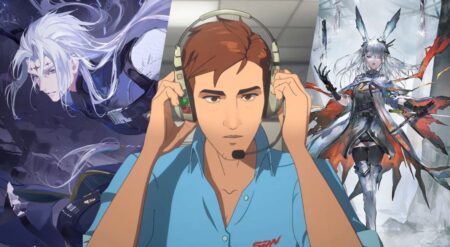Critics and audiences have been loud and clear in their response to Joker: Folie à Deux. Boasting the lowest Cinemascore ever for a comic book film, getting dismal box office results, and savage reviews, the Todd Phillips-helmed follow-up to 2019’s multiple Oscar-winning Joker is an unmitigated disaster of the sort that has the trades speculating as to what went wrong. What did go wrong, exactly? Well, in this writer’s opinion, nothing. Joker: Folie à Deux is a purposeful deflation of the visceral mania that colored the first film. In other words, the joke in Joker: Folie à Deux is on the audience, and it’s a damn good one. Full spoilers follow.
A key focus in Scott Silver and Todd Phillips’ script for Joker: Folie à Deux is the public’s reaction to the deeds of Arthur Fleck/The Joker (Joaquin Phoenix). Mirroring the fears many had in the lead-up to the first film’s release, there are those who see Arthur as a hero of sorts. At first, Arthur and the film itself play into this adoration. Joaquin Phoenix, as always, does a phenomenal job at not only portraying the deep trauma that resides inside Arthur but also a sort of narcissism that springs out of the adoration. Once Arthur starts having musical fantasies of his grandeur, it comes in the form of gorgeously shot musical numbers on bright, very expensive-looking sets by cinematographer Lawrence Sher.
Are the musical numbers indulgent? Yes. But they reflect Arthur’s mental state exquisitely. Maryanne Stewart (Catherine Keener), Arthur’s lawyer, concocts a narrative that the Joker is in a separate persona and that the murders committed by Arthur happened whenever he blacked out and slipped into the Joker persona. This mirrors some readings of the initial film that Arthur was an inherently good person who unleashes a monster after society pushes him. In a twist on audience expectations, that doesn’t turn out to be the case at all.
Much of Joker: Folie à Deux is set inside the Gotham courtroom, where District Attorney Harvey Dent (Harry Lawtey) seeks the death penalty for Arthur. In a key scene, Gary Puddles (Leigh Gill), a former co-worker of Arthur in his clown days who witnessed one of his murders, expresses that Arthur was one of the only people who was nice to him, but due to his actions had now made Gary, who is a little person, feel even smaller and scared. This interaction makes Arthur capitulate the next day in court, admitting that the Joker persona was not a split personality and was fully aware of what he was doing.

It feels as much a reveal to the audience as it is a frustrated underlining by Todd Phillips of what he intended with the character. He wanted Arthur to be read as a profoundly unwell person who took selfish actions due to his insecurities, and for people to read him as aspirational didn’t sit well with Phillips. This is especially apparent in the portrayal of Harleen “Lee” Quinzel (Lady Gaga). Quinzel, who poses as a patient in Arkham State Hospital to get closer to Arthur, idolizes his actions. She encourages his lapses into fantasy, this grand idea of Arthur seeing himself as a singer on a technicolor stage.
Joker: Folie à Deux makes a fascinating dichotomy between Arthur’s fantasy world of the musical numbers and the grungy “hospital” he’s staying in. One is the actual brutal reality, where Arthur is assaulted mercilessly by the guards led by Jackie Sullivan (Brendan Gleeson). The other is a fantasy that’s somewhat comforting for Arthur but more so for the romanticizing Lee, who gets off on the idea of inserting herself into the life of she is a misunderstood hero. The whole character of Harley Quinn in this film is a brilliant commentary on both true crime obsession and those who take the wrong messages out of art. She is the toxic Joker fan.
However, like the audience of this film, when Arthur rebukes the idea that he isn’t in control of his actions, the crowd outside the courthouse riots, causing an explosion. A few crazed Joker fans attempt to help Arthur, but he runs away, only to find Lee waiting on the iconic steps, telling him that the fantasy is over. When Arthur gets sent back to prison, awaiting execution, another prisoner murders him before laughing maniacally and carving “smile” scars into his face.
On the surface, this is meant to imply that Arthur was merely the inspiration for the actual Joker. More than anything, it means that his story never mattered. His violent actions were for nothing other than a stepping stone to someone else’s story. All his grandeur did was lead him to die alone in prison. That’s the punchline. And I’m honestly in awe of it.

Joker: Folie à Deux is a dark mirror to the first film. It’s a response to fans of the first film who took it the wrong way. Hell, it’s a powerful indictment of true crime obsession. But most of all, it’s a comic book movie unlike any other, one that antagonizes the audience and challenges their preconceived notion of what a comic book movie can and should be. The reception it’s getting is just validation of the movie’s point. If the first Joker was an edgy Taxi Driver clone, Joker: Folie à Deux is a true original that will remain in the conversation far longer than we may anticipate. Todd Phillips and Joker: Folie à Deux already got the last laugh.
Joker: Folie à Deux is currently playing in theaters.







